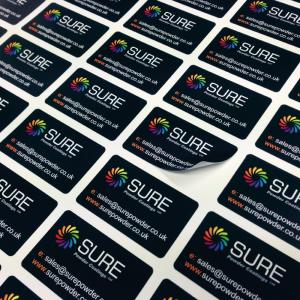Exploring the Conveniences of Blank Labels and Their Compatibility With Full-Colour Labels
Space tags, commonly overlooked, hold a secret expertise worldwide of advertising and item management. Their convenience and adaptability across different markets make them a valuable possession. Combined with full-colour tags, they can enhance item recognition, inventory administration, and advertising and marketing effectiveness. The striking contrast they develop can record consumer interest and share brand name values. Intriguingly, the combination of empty and full-colour tags can foster a distinct visual that advertises distinction and clarity in a competitive market. The inquiry after that arises, exactly how can one optimize these advantages?
Comprehending the Fundamental Idea of Blank Labels
While they may seem simple in the beginning glance, empty tags hold a substantial area in numerous markets. They develop the foundation of product identification, supply monitoring, and quality assurance. These apparently harmless tools of communication are, as a matter of fact, giants of info.

Their blank nature provides them a global application, all set to be customised according to the individual's demands. They can be published on making use of various approaches like thermal transfer, straight thermal, laser, or inkjet, therefore making them versatile.
Various forms and dimensions provide to the myriad demands of industries, ranging from the small circular labels on pharmaceutical vials to large rectangle-shaped ones on delivery dog crates. Therefore, blank tags, in their simplicity, perform crucial features that keep industries running efficiently.
The Unequaled Flexibility of Space Labels
Space tags, in their plain visibility, symbolize an unparalleled versatility that establishes them apart - full-colour labels. This adaptability hinges on their ability to be made use of across myriad applications and markets. From retail and logistics to drugs, they work as a versatile yet durable device in managing, organising, and recognizing products
Their customisability is one more exceptional element, supporting a variety of printing modern technologies. Whether it's thermal, laser, or inkjet printing, blank labels can fit various approaches, catering to particular demands.
In addition, they can be tailored to various shapes, dimensions, and products, showing an adaptability that surpasses the normal constraints of pre-printed tags. This enables on-demand printing, providing companies with the flexibility to layout and print tags as required.
In essence, the versatility of blank labels comes from their simplicity, versatility, and compatibility with varied printing modern technologies and products. It's these top qualities that make them an essential possession in various markets.
Cost-Effectiveness: A Secret Benefit of Blank Labels
One considerable advantage of blank labels is their cost-effectiveness. This can be appreciated in several ways, such as the decrease in printing expenditures, the savings made from bulk acquisitions, and the reduction of waste generation. Each of these elements adds to making empty labels an affordable option for companies.
Lowering Printing Expenditures
One efficient approach is by reducing printing costs via the usage of blank labels. Unlike pre-printed tags, empty tags eliminate the requirement for pricey shade printing, thus saving on the ink price. The unification of blank labels can be a calculated choice for organizations aiming to enhance cost-effectiveness and performance in their procedures.

Mass Purchase Cost Savings
Numerous organizations find that purchasing empty tags in bulk can lead to significant cost savings, further boosting their cost-effectiveness. The rationale behind this is simple; distributors commonly offer rate breaks for larger orders, reducing the system cost of each tag. Businesses have to stabilize these advantages versus storage space constraints, as large quantities of labels need considerable storage area.
Lessening Waste Generation
While blank tags supply several benefits, their prospective to minimize waste generation can not be overstated. This characteristic adds considerably to their cost-effectiveness. By permitting individuals to publish only what is needed, empty labels get rid of the excess typically connected with pre-printed tags. This, consequently, lowers waste and the costs connected to garbage disposal. In addition, empty tags' flexibility enables for final changes or updates without the requirement to dispose of obsolete or incorrect labels, further reducing waste production. By reducing the use of unneeded products, empty tags Read Full Article advertise eco friendly practices. Thus, making use of blank labels not only verifies affordable but also aligns with sustainable and accountable service methods.
Just How Blank Labels Enhance Branding Opportunities
The role of blank labels in enhancing branding possibilities can not be taken too lightly. By giving adaptability in design selections, Find Out More they enable services to craft distinct, compelling visuals that mirror their brand name identity. Just as vital is the function these tags play in increasing brand presence, offering as a constant reminder of the company to consumers.
Flexibility in Layout Choices
Supplying an exceptional degree of adaptability, blank labels present services with countless opportunities for customizing their product packaging. They can be developed with any type of logo design, message, or visuals and can be published in any kind of colour, allowing businesses to tailor their labels to their certain brand name identification. Space tags, after that, are not simply a functional requirement, but a tactical tool for company branding.
Increasing Brand Name Presence
To increase brand name presence, empty tags function as a very reliable device. They use a canvas for creative thinking, making it possible for an organization to apply personalized layouts that record its special identification. This versatility guarantees try this website the brand is not confined to pre-made templates, thus providing a possibility to attract attention in the congested market. Empty labels can be utilised across numerous item lines, preserving consistency in brand name presentation. In combination with full-colour tags, they produce a striking aesthetic comparison that gets customer interest. This technique enhances acknowledgment and recall, vital aspects of brand name exposure. Therefore, by leveraging the possibility of blank tags, services can considerably magnify their brand's market presence.
The Symbiotic Connection In Between Blank and Full-Colour Labels
Although differing in their use, empty and full-colour tags have an one-of-a-kind, symbiotic connection that improves their private worth. Space tags, with their minimal style, deal flexibility and adaptability, making them ideal for numerous applications. Their simplicity permits for customisation, supplying a canvas for creativity and personalisation.
Their impact is amplified when paired with empty tags. The empty tags can take in and reduce the effects of the intensity of full-colour labels, preventing them from overwhelming the customer's detects. Concurrently, the full-colour labels amplify the effectiveness of empty tags, keeping them from appearing also ordinary or boring.
Real-world Examples of Effective Space and Full-Colour Label Integration
Have you ever contemplated just how ubiquitous brands use a blend of blank and full-colour tags to maximize their product allure? One striking example is Apple Inc., a company recognized for its minimal product layout. Its packaging employs a comparison of blank and full-colour tags, highlighting the product's streamlined aesthetic appeals. The brand name and item type, emblazoned in full-colour, attract attention against the empty backdrop, creating an attractive visual dynamic.
Furthermore, Coca-Cola efficiently makes use of full-colour labels on its timeless red cans, with empty tags on its 'Zero Sugar' version, subtly communicating a much healthier choice. Nestlé additionally significantly utilizes blank tags for its 'Pure Life' canteen, contrasted with full-colour tags for its flavoured water choices. These real-world examples demonstrate the effective use of empty and full-colour labels in improving item charm and communicating brand name worths, confirming that a judicious mix of both can undoubtedly be a successful advertising technique.
Verdict
In final thought, the integration of blank labels with full-coloured tags offers businesses a distinct, affordable branding strategy. Their adaptability across different markets boosts item recognition and supply monitoring, while their compatibility with full-colour tags raises advertising efficiency. By striking an equilibrium between both, firms can catch consumer focus, advertise brand distinction, and enhance brand name identity in an affordable marketplace. The sensible use of these tags can therefore generate significant company benefits.